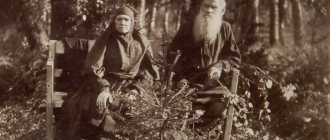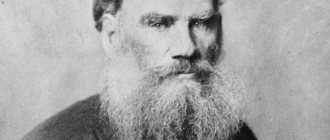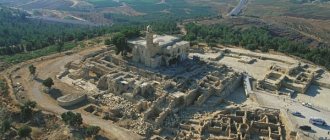short biography
Lev Nikolaevich was born into a large noble family in the Yasnaya Polyana estate. Then this area was called the Tula province, and now it is the Shchekinsky district of the Tula region. He spent most of his life on this estate and was buried there. In 1921, Yasnaya Polyana received the status of a museum and is currently a natural museum-reserve.
His father was Count Nikolai Ilyich Tolstoy, and his mother was Princess Maria Nikolaevna Volkonskaya (after the marriage she became Countess Tolstoy). There were five children in the family; he had three brothers and one sister.
He became an orphan as a child - his mother died when he was 1.5 years old, and at the age of nine he lost his father. His aunt Countess Alexandra Ilyinichna Osten-Sacken (née Tolstaya) became the guardian of all five children.
In 1844 he entered Kazan University, then called the Imperial Kazan University. At first, Tolstoy studied at the Faculty of Oriental Studies (he studied Arabic and Turkish), then he switched to law. 2.5 years after the start of his studies, in 1847, he left the university and returned to Yasnaya Polyana.
In 1851 he travels to the Caucasus with his older brother Nikolai Nikolaevich Tolstoy (his brother’s place of service). There he participated in military operations, first as a volunteer, and then as an artillery officer.
In 1852, he sent his manuscript of the story “Childhood” to N. A. Nekrasov. Then Tolstoy wrote in his journal: “He will either encourage me to continue my favorite activities, or force me to burn everything I started.” The famous writer appreciated his work, which was published in September of the same year.
In 1854 Lev Nikolaevich was sent to the Danube Army. After the outbreak of the Crimean War (1853–1856), at his own request, he was transferred to Sevastopol.
In 1862 he married Sofya Andreevna Bers, they were married until his death, for 48 years. From this marriage 13 heirs were born.
At 82, the writer secretly left home (Yasnaya Polyana). On the way, he fell ill with pneumonia and was forced to stop at the small Astapovo station, and soon died. This is considered the cause of the writer’s death.
No one knows for sure what exactly happened in those last days: there were many people around him, every step of the writer was documented, but the reasons for his leaving home are still unknown.
Childhood
The date of birth of Lev Nikolaevich is August 28 (September 9), 1828. The future writer was born on his mother's estate Yasnaya Polyana, located in the Tula province. The parents of the future writer belonged to the count branch of the old noble Tolstoy family.
Little Leo was left early without his mother's love and care: the cause of his mother's death was a difficult birth, and two-year-old Lev and his older brothers and sister were raised by relatives-guardians. After the death of their father, the orphaned children moved to Kazan to live with their aunt, P.I. Yushkova.
The Yushkov house was very cheerful and hospitable, the aunt loved her nephews with all her heart, took care of their education, and Leo Tolstoy’s childhood was truly happy. He later described these years in his autobiographical story “Childhood.”
His creativity and most famous works
His works include more than 300 articles and open letters (for example: “What is art?”, “The Great Sin” and “It’s Time to Understand”). In 1872 he published the ABC. His diaries have also reached us, which he kept from his student days (1854) until almost his death (the last entry was made 4 days before his death in 1910). Perhaps his most famous works are:
- Childhood (first published work, 1852)
- Boyhood (1854)
- Sevastopol Stories (1855)
- Youth (1857)
- Family Happiness (1859)
- War and Peace (1867)
- Prisoner of the Caucasus (short story, 1872)
- Anna Karenina (1873–77)
- Decembrists (publ. 1884)
- Fertile Soil (last published work, 1910)
Tolstoyism
There is a religious and philosophical movement called Tolstoyism, created on the basis of his ideas. Very briefly, the main meaning of the movement: everything simple is useful to a person, and everything complex is wrong.
Nobel Prize
He was never awarded the Nobel Prize, because the writer himself did not want to receive it.
Lev Nikolaevich was nominated for the Nobel Prize several times:
- Peace Prize in 1901, 1902 and 1909
- prize for literature every year in 1902–1906.
Lev Nikolaevich asked his friend the Finnish writer and translator (named Arvid Järnefelt) to make sure that this prize was not awarded to him
He explained it this way: “if this happened, it would be very unpleasant for me to refuse” and “all money, in my opinion, can only bring evil.” The Finnish writer complied with his request.
Literature
Tolstoy's creative path began in the Caucasus, where Tolstoy spent three years. It was there that he composed the story “Childhood,” followed by the stories “Adolescence” and “Youth,” which made up an autobiographical trilogy.
His literary debut in the Sovremennik magazine turned out to be successful, and Lev Nikolaevich decided to devote himself entirely to literature. Soon from his pen came the series “Sevastopol Stories”, dedicated to the Crimean War and the defense of Sevastopol, in which he personally participated.
Returning to St. Petersburg, Tolstoy became a member of the Sovremennik literary circle, where he was sincerely admired. However, the writer quickly got tired of the bustle of the capital and went on a trip to Europe. Upon returning to Yasnaya Polyana, he began arranging schools for peasant children. He wrote “The ABC,” as well as hundreds of good and instructive fairy tales for the little ones.
Tolstoy’s most important works were the novels “Anna Karenina” and “War and Peace,” the contents of which are known to almost everyone. These are deep psychological works in which the writer delicately revealed not only the inner world of the characters, but also reflected the most important social problems of society.
In the 1880s, there was a turning point in the writer’s consciousness, which was reflected in the works: “The Kreutzer Sonata”, “The Death of Ivan Ilyich”, “After the Ball”, “Father Sergius”. Through his novels and short stories, Tolstoy spoke out against social inequality, the idleness of the nobles, the immorality and emptiness of life of the ruling class.
Procession
On November 23 – still in the presence of thousands of mourners and government officials – the coffin with Tolstoy’s body was taken into the hands of his friends and associates and carried towards the forest where Tolstoy and his brother played as children and where they were looking for the magic “green stick”, which was supposed to bring happiness to all humanity.
The coffin was made of oak, there was no cross on the lid. Participants in the funeral procession sang “Eternal Memory.” A large handwritten banner was carried in front of the coffin with the following words:
“Lev Nikolaevich! The memory of your goodness will not die among us, the orphaned peasants of Yasnaya Polyana.”
VIP funeral
Funeral
When the procession reached the place, the coffin with the deceased was lowered into the grave - while all the mourners knelt. The police officer on duty at the coffin, who was tasked with maintaining order at the ceremony, noticed that one of his subordinates did not kneel, remaining standing alone among all those gathered, and then shouted “Police, on your knees!” the officer forced him to follow the example of those around him. A hill was built over the grave, on which there was neither a cross nor a tombstone, and no flowers were planted in the semicircular clearing around it. This is what the writer’s grave looks like to this day.
On the day of the funeral, newspapers published part of the speech of Emperor Nicholas II on the death of the writer:
“I sincerely regret the death of the great writer, who, during the heyday of his talent, embodied in his works the images of one of the glorious times of Russian life. May the Lord God be his merciful judge.”
II
“A concert of the world famous performer of works by Chopin, Liszt and Brahms, pianist Gottfried Galston, was scheduled for November 9,” recalls Andrei Leskov (“Orlovskaya Pravda,” 1940, November 20) about the concert that did not take place in Moscow. “On the occasion of Tolstoy’s death, not many people gathered at the appointed hour. A lone policeman languished at the entrance. There was talk about the possible cancellation of the concert. But then Galstop came out onto the stage, silently sat down at the piano... and the solemn, majestic sounds of Chopin’s funeral march floated through the hall. Everyone stood up. With the last chord, Galston stood up and left silently. The next day it became known that Galston was fined 100 rubles for publicly demonstrating his admiration for the memory of the deceased writer.”
Quiet hill
The grave of Leo Tolstoy is distinguished by a special privacy - the first to feel this, of course, were the writer’s relatives and friends:
“It was a warm day, there was wind, I went out for the first time and went, of course, to the grave of Lev Nikolayevich,” the widow Sophia Tolstaya wrote in her diary on April 23, 1911. “The bells were ringing loudly in the distance. “Christ is risen” sounded all over Russia, but in the forest, at the grave it was quiet, quiet; dried wreaths swayed in the wind, and I prayed and cried.”
Another visitor described his impressions like this:
“You need to have Tolstoy’s pen to convey the feelings overwhelming here, in front of the contours of Leo Tolstoy’s grave. You stand alone in the forest, you don’t trust either these thin nut trees or yourself. To the left is the forest. To the right is a dreary young thicket. There is a ravine nearby. This is where, finally, Lev Nikolaevich found solitude for himself.”
When in Soviet times they tried to plant flowers on the grave, local enthusiast Nechaev, the founder of the museum in the Kuzminsky wing, argued with this:
“I always object to the fact that flowers are planted on Tolstoy’s grave: his grave should be overgrown naturally... This greatest man must naturally dissolve in the Cosmos, from where he came to this Earth” (quoted from the notes of the Bolshevik Mikhail Present).
During the German occupation during the Great Patriotic War, as Soviet newspapers reported, Tolstoy's grave was desecrated. But today the grave mound, overgrown with grass, has been restored and improved. A symbolic fence appeared along the perimeter at a distance of several meters from the grave. On Tolstoy’s days, admirers of the Russian classic lay flowers on the hill, but at other times the grave probably looks as “natural” as it did in 1911.
IV
When the news of the death of the great writer spread across Russia, the Kostroma newspaper “Severnaya Zarya” came out with a large portrait of Leo Tolstoy on the front page, framed by a mourning frame. The same issue published a call for a public civil memorial service. Early in the morning, the police burst into the printing house and destroyed all copies of the newspapers, with the exception of some that they managed to take out and put on sale. A significant fine of 500 rubles was imposed on the newspaper publisher, the editor on duty was administratively sent to prison for 3 months, and the newspaper was closed (Taganrogskaya Pravda, 1960, November 20).
Interesting Facts
- Leo Tolstoy is known not only as the author of serious works. He also wrote The ABC's and The Reading Book for children.
- At the end of his life, Tolstoy called his largest and most significant work, “War and Peace,” “wordy rubbish.”
- Lev Nikolaevich Tolstoy had the noble title of count.
- Tolstoy was fond of social life and playing cards. He always played very recklessly and often lost, which negatively affected his financial situation.
- Tolstoy sharply criticized Shakespeare’s talent as a playwright and even published an essay “On Shakespeare and Drama” with a detailed analysis of some of his works.
- After his death, Tolstoy was left with a wife and 8 children. In total, the couple gave birth to 13 children.
- see all the interesting facts from the life of Tolstoy
Personal life
In a brief biography of Leo Tolstoy, it is important to note that his chosen one was 18-year-old Sophia Bers, who was 16 years younger than her husband. This marriage turned out to be successful, although disagreements arose more than once between the spouses.
In 1863, there was an addition to the family: the first-born of the Tolstoy couple was born. There is information that in total Sofya Andreevna gave birth to 13 children, five of whom did not live to adulthood. For many years she was a faithful friend and ally of Lev Nikolaevich, helped and supported in every possible way, and completely protected him from solving everyday issues.
Lev Nikolaevich Tolstoy died on November 7 (20), 1910, at the 83rd year of his life. The cause of death was a common cold, which gave rise to a severe complication - lobar pneumonia. The writer was buried, as he himself bequeathed, in Yasnaya Polyana, on the edge of a ravine in the forest. His happy years passed here, and here he and his brothers in childhood were looking for a “green stick” that could make all people happy.
Where is Leo Tolstoy buried?
Tolstoy interpreted the New Testament in his own way and himself renounced the Church. The writer called church teachings lies, and the Sacraments - witchcraft. The Synod had to legitimize Tolstoy's existing rejection of the Church and excommunicate him from it. Even in his youth, Lev Nikolaevich dreamed of forming a “new religion” without mystery. The writer depicted his position in the article “How to read the Gospel?” From it we can conclude that Lev Nikolaevich was a deeply religious person, he simply understood the teachings of Christ in his own way.
There were many people who approved of the writer's views on religion; they saw him as a hero and sent Tolstoy letters. And Tolstoy’s relatives were guided by his personal wishes and buried him according to his will. It’s not difficult for you to guess where Leo Tolstoy was buried. Of course, in the family estate of his Yasnaya Polyana. The grave of the genius is located in a quiet park alley. It was not decorated in any way and no marks were made on it. Truly it can be said that a great man is great even in death. He was buried like the simplest peasant.
Parting
From Astapovo the writer's body was taken to his estate in Yasnaya Polyana. On November 22, 1910 (new style), several thousand people came there to bid farewell to Tolstoy, among whom were students from Moscow, local peasants, townspeople, as well as government officials and police officers - the authorities feared that farewell to the writer would turn into anti-government performance.
The farewell ceremony for Tolstoy went down in Russian history as the first secular one. This was the first public funeral of a famous person in the country that was not held according to Orthodox or other religious rites. As the count bequeathed, there were no priests, no icons, no candles at the ceremony. The people who escorted the writer's body from the station to the estate sang quietly. When the body was placed in one of the rooms of the estate, the mourners took turns entering and silently said goodbye to him.









